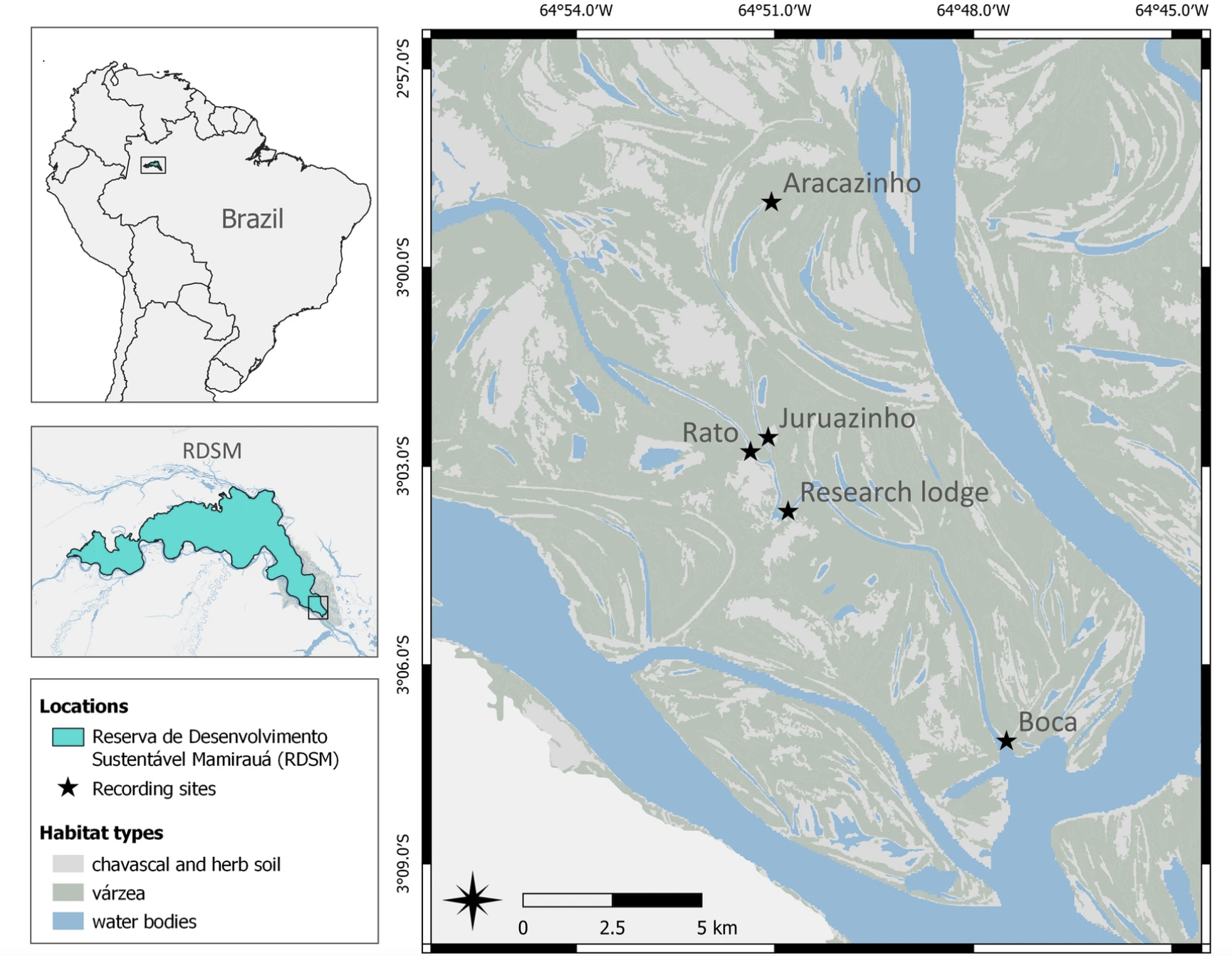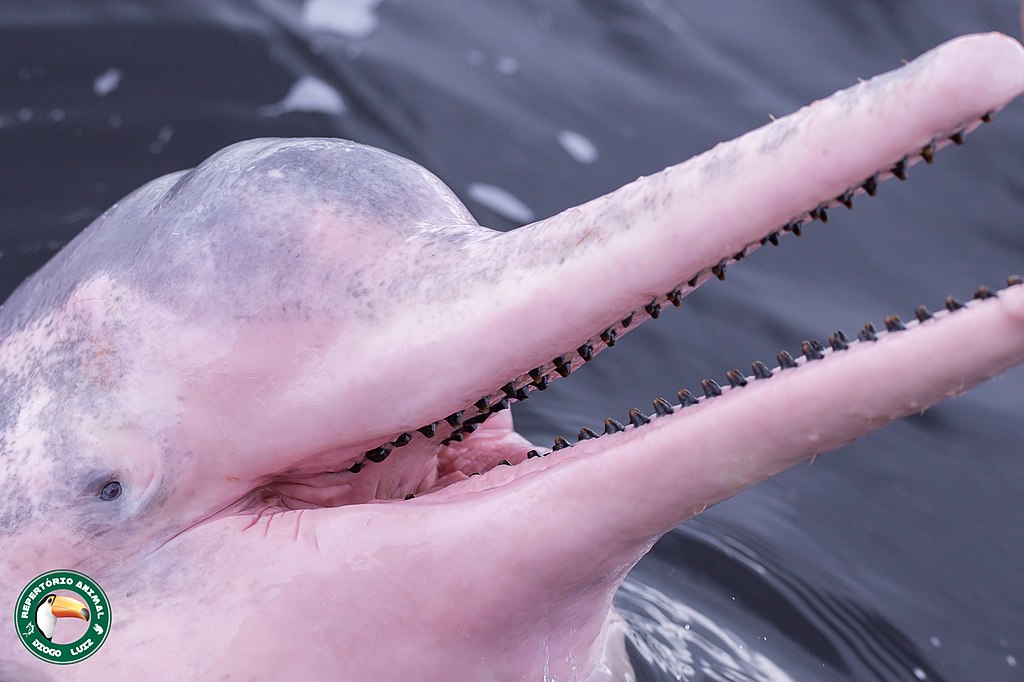- Freshwater dolphins in the Amazon Basin navigate through flooded forests during the wet season using their flexible bodies and echolocation clicks.
- Researchers have combined advanced acoustic monitoring and AI to study the habits of endangered pink river dolphins (boto) and tucuxi in seasonally flooded habitats.
- They used hydrophones to record sounds in various habitats and employed convolutional neural networks (CNN) to classify the sounds as either echolocation clicks, boat engine noises, or rain — with high accuracy.
- Understanding the dolphins’ movements and behaviors can aid conservation efforts to protect these endangered species, as they face various threats such as fishing entanglement, dam construction, mining, agriculture and cattle ranching.
Freshwater dolphins navigate the waterways of the Amazon Basin. In the wet season, water spills from the rivers, flooding parts of the forests. The dolphins go, too, using their exceptionally flexible bodies and echolocation clicks to navigate a maze of submerged greenery.
Researchers who study the dolphins typically use boats to follow and sometimes tag the animals, but this is nearly impossible in floodplain forests. As a result, the habits of two endangered freshwater species — the pink river dolphin or boto (Inia geoffrensis) and the tucuxi (Sotalia fluviatilis) — have been shrouded in mystery until recently.
Researchers from the Technical University of Catalonia, Spain, and the Mamirauá Institute of Sustainable Development in Tefé, Brazil, have successfully combined advanced acoustic-monitoring techniques and artificial intelligence to shed light on the movements and behaviors of these dolphins in their seasonally flooded habitats. Their results are published in the journal Scientific Reports.

The researchers submerged powerful recording devices called hydrophones to depths of 3-5 meters (10-16 feet) at various spots across an area covering approximately 800 square kilometers (309 square miles) of the Mamirauá Sustainable Development Reserve in Amazonas state. The hydrophones recorded sounds from various habitats, including river channels, confluence bays, floodplain lakes, and flooded forests during both wet and dry seasons between June 2019 and September 2020.
To analyze these recordings, they employed convolutional neural networks (CNN), a type of deep-learning algorithm, to automatically classify the detected sounds into distinct categories: echolocation clicks from dolphins, boat engine noises, and rain. The system achieved impressive accuracy of 95%, 92% and 98% for each respective sound type. With this technology, the researchers discovered intriguing patterns in the movements and behavior of the dolphins.

As water levels rose between November and January, dolphins went from spending 10% of their day in bay and river channels to 70%. From this, the researchers inferred that the dolphins used these waterways to access the floodplains. Furthermore, the study revealed that boto (I. geoffrensis) adolescents and females with calves spent more time in the floodplains than males, potentially seeking abundant prey or shelter from aggressive male behavior.
The tucuxi population is declining by 50% every nine years. The boto population is declining by 50% every 10 years, with predictions of a 95% reduction within 50 years. The authors say this research has significant implications for conservation strategies.
Understanding the habitat preferences and requirements of the dolphins can help conservation managers develop targeted approaches to protect these endangered species. Likewise, monitoring how the dolphins respond to habitat loss and degradation, such as deforestation for pastures and plantations, can aid in managing the entire ecosystem.
“As sentinel species of the aquatic systems they inhabit, river dolphins can constitute an early detection system of ecosystem unbalance,” the authors write.

The boto and tucuxi face various threats, including entanglement in the gill nets of fishers and being captured for bait in the commercial fishery of piracatinga (Calophysus macropterus), a large Amazonian catfish.
Another recent study tracking the movements of river dolphins in Peru found that 89% of their home range is subject to fishing activity. This study relied on fitting the dolphins with satellite tags to be able to monitor them.
Disturbances to water quality and habitats caused by dam construction, mining, agriculture and cattle ranching also threaten the dolphins.
Last year, another group of researchers tagged some Amazon river dolphins with radio transmitters in the Amanã Sustainable Development Reserve, also in Amazonas state. They were able to map the dolphins’ preferred zones and identify priority regions for species protection. Hydroelectric dams, fishing and contamination from mining are the biggest threats to the species across this range.
Acoustic monitoring and deep learning used in the recent study are less stressful for the dolphins than capturing and tagging them. They may prove a more effective long-term and automatic way to study these populations. The authors call for this technology to be widely used across the Amazon.
Citation:
Erbs, F., Gaona, M., van der Schaar, M., Zaugg, S., Ramalho, E., Houser, D., & André, M. (2023). Towards automated long-term acoustic monitoring of endangered river dolphins: A case study in the Brazilian Amazon floodplains. Scientific Reports, 13(1), 10801. doi:10.1038/s41598-023-36518-1
Campbell, E., Alfaro-Shigueto, J., Mangel, J. C., Mena, J. L., Thurstan, R. H., Godley, B. J., & March, D. (2023). Satellite-monitored movements of the Amazon River dolphin and considerations for their conservation. Oryx, 1-11. doi:10.1017/S0030605322001557
Campbell, E., Alfaro-Shigueto, J., Aliaga-Rossel, E., Beasley, I., Briceño, Y., Caballero, S., … Godley, B. J. (2022). Challenges and priorities for river cetacean conservation. Endangered Species Research, 49, 13-42. doi:10.3354/esr01201
Banner image of boto displaying aerial behavior in the Mamirauá Sustainable Development Reserve. Image courtesy of Marina Gaona/IDSM.
FEEDBACK: Use this form to send a message to the author of this post. If you want to post a public comment, you can do that at the bottom of the page.
Fishing, dams and dredging close in on Peru’s river dolphins, study shows
